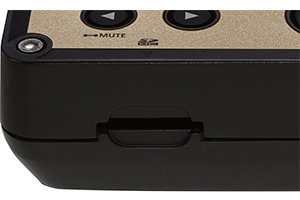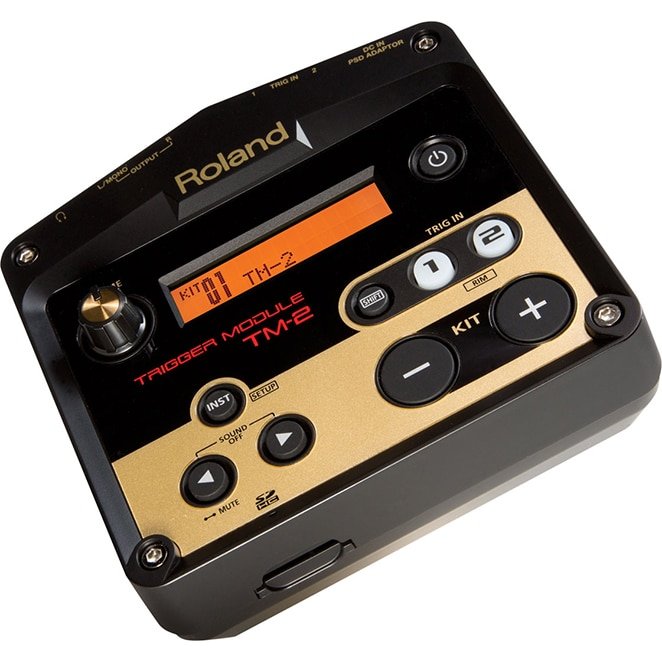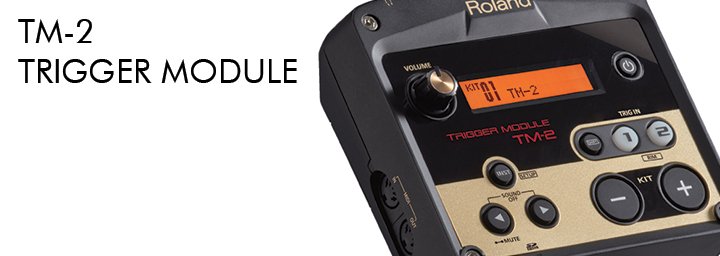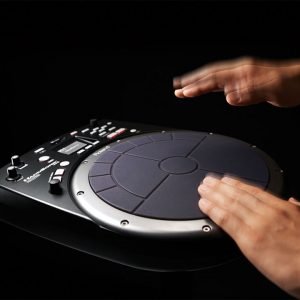Roland’s TM-2 promises to open the world of electronic percussion for acoustic drummers, but also offers something for e-drum purists. Allan Leibowitz took the mini-module for a spin.
There has already been plenty of debate about the TM-2, but much of the posturing ignores the obvious: this is a drum enhancement product, not a module substitute. If we look at it from the perspective of an acoustic drummer who would like to add some colour and texture to their sound palette, we can fully appreciate what Roland has set out to do.
What’s In The Box?
The TM-2 is an ultra-compact, battery-powered (with AC option), four-input (via two stereo jacks) ‘trigger module’. It ships with a power supply and a mounting plate.
The TM-2 is designed to be ultra user-friendly for our less tech-savvy acoustic counterparts. There are two stereo inputs and two mono outputs on the back, together with a 3.5 mm stereo socket. On the side, you’ll find MIDI In and Out sockets, while the front has a slot for an SD card.
There are a few oversize buttons on the face to change kit selections and perform other rudimentary tasks – all pretty much idiot-proof and self-explanatory.
How It Works
The TM-2 is designed for a new approach to drum enhancements, and there are no hard and fast rules about how it should be used. I tried various permutations, but I suspect most users will connect one input to a stereo external trigger mounted on the snare with the second input split between a kick trigger and perhaps an aux trigger like Roland’s BT-1.
The module is pre-loaded with 162 sounds arranged in 50 kits. There are another 49 blank kits which can be loaded with stock sounds or .WAV samples on the SD card. Here, users can load their own sounds – anything from single sounds to loops or full backing tracks. The stock sounds fall into two rough categories: instrument sounds like a snare, cowbell or hi-hat strike; and ‘elements’. The latter take a bit more thought as these are enhancements to acoustic sounds. For example, if you need the slap of a bass drum beater on the head to augment your existing bass drum sound, the module can add that. If you want a sustained snare rattle to trail off after the crack of your acoustic drum, the trail can be added – and you can even delay it slightly so that it follows the crack at a predetermined time.

In Action
The TM-2 is child’s play to connect and even a first-timer will be up and running in minutes.
The module accepts inputs from pretty much any trigger in the Roland stable, and certainly had no difficulty with any of the third-party triggers with which I tested it. There are a range of onboard trigger settings including all the KD types, the new KT-10, all the PD and Cy versions, Roland’s BT-1 settings and its RT external trigger as well as a couple of generic settings, PAD1 and 2. And these settings, as with other modules, can be adjusted on various parameters, from sensitivity to Xtalk. One solution I tried, and which I am sure will prove popular, is paring the TM-2 with Aquarian’s inHead. I fitted the inHead to a 14” acoustic snare, added the Rimshot unit and the inBox adaptor and, after a bit of trigger tweaking, had the elements working perfectly together.
The sounds are also very easy to work with. Sounds can easily be reassigned from one kit to another, and can also be edited. For example, they can be pitched up or down, panned from left to right and set to various volumes, but perhaps the most important tweak for acoustic augmentation is the offset parameter. Essentially, this allows you to delay the start of the sound after triggering. For example, by delaying a bass hit, one can easily produce a double hit to emulate a lightning fast metal player with half the effort.
This editing capability can also be applied to imported .WAV samples. So, for example, I was able to add bottom end to a tambourine sample I imported from a VST pack.
One word of caution on sample imports – the module is velocity sensitive, so you’ll get louder and softer versions of the sample when you strike at different intensities, but it will be the same sample that is played each time, so you would certainly get annoying machinegunning if you were, for example, to import a snare hit and attempt to produce rolls with it.
While there aren’t all that many of them (compared to a full-size Roland module), the stock sounds are very impressive and some of the drum, cymbal and percussion instruments are fantastic on their own. The augmentation effects which can be layered into acoustic sounds or set to trigger after them are equally impressive and offer untold creative opportunities.
The module also has a decent palette of FX including reverb, delay, chorus, phaser, flanger, wah, distortion and compression – all of which can be dialled up or down.
The Verdict

digitalDrummer has been flagging the rise of hybrid drumming for some time and this product exemplifies the approach. In a compact, easy-to-use unit, Roland is offering acoustic drummers an easy entry into the world of electronic opportunities. Whether it’s Bohemian Rhapsody which needs a massive gong at the end or a disco track that needs claps and tambourines, the TM-2 provides additional sounds without the expense of a topend module and triggers.
The TM-2 is versatile, connecting to almost any trigger (we didn’t find one that didn’t work with it), to add electronic capability for acoustic drummers. Its sound palette is limited, but well chosen and easily augmented thanks to the easy import function for .WAV files through an SD card.
In short, a couple of hundred bucks, a few triggers and a very quick browse of the instructions will have any acoustic drummer up and away in no time.
I can see this solution becoming very popular among gigging acoustic drummers and it could well take off if combined with something like Aquarian’s inHead – an acoustic head with electronic trigger sensors built in.
In short, as a replacement for a high-end, multi-input module, the TM-2 will disappoint. But paired with an acoustic kit, some creativity and a few high-quality samples on its SD card, I can see this as a turning point in the evolution of drumming.
Specifications
Kits: 99
Internal instruments: 162 User instruments
Number of instruments: Maximum 90,300
File Format: .WAV (44.1 kHz, 16 bits, Stereo/Mono)
Storage Media: SD/SDHC Memory Card (Max. 32 GB)
Effects: 11 types
Display: 16 characters, 2 lines (backlit LCD)
Connectors
► OUTPUT (L/MONO, R) jacks: 6.5 mm phone type
► PHONES jack: Stereo miniature phone type
► TRIG IN jack x 2: 6.5 mm TRS phone type
► MIDI (IN, OUT) connectors
► DC IN jack
Power Supply AC adaptor
AA batteries x 4









